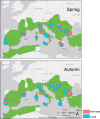Hydrogen isotopes reveal evidence of migration of Miniopterus schreibersii in Europe
- PMID: 32993600
- PMCID: PMC7526252
- DOI: 10.1186/s12898-020-00321-7
Hydrogen isotopes reveal evidence of migration of Miniopterus schreibersii in Europe
Abstract
Background: The Schreiber's bat, Miniopterus schreibersii, is adapted to long-distance flight, yet long distance movements have only been recorded sporadically using capture-mark-recapture. In this study, we used the hydrogen isotopic composition of 208 wing and 335 fur specimens from across the species' European range to test the hypothesis that the species migrates over long distances.
Results: After obtaining the hydrogen isotopic composition (δ2H) of each sample, we performed geographic assignment tests by comparing the δ2H of samples with the δ2H of sampling sites. We found that 95 bats out of 325 showed evidence of long-distance movement, based on the analysis of either fur or wing samples. The eastern European part of the species range (Greece, Bulgaria and Serbia) had the highest numbers of bats that had moved. The assignment tests also helped identify possible migratory routes, such as movement between the Alps and the Balkans.
Conclusions: This is the first continental-scale study to provide evidence of migratory behaviour of M. schreibersii throughout its European range. The work highlights the need for further investigation of this behaviour to provide appropriate conservation strategies.
Keywords: Chiroptera; Climate change; Long-distance migration; Movement ecology; Schreiber’s bat; Stable isotope; Wildlife conservation.
Conflict of interest statement
None declared.
Figures


References
-
- Hutterer R, Ivanova T, Meyer-Cords C, Rodrigues L. Bat migrations in Europe: a review of banding data and literature. Bonn: German Agency for Nature Conservation; 2005.
-
- Hutson AM, Aulagnier S, Benda P, Karataş A, Palmeirim J, Paunović M. Miniopterus schreibersii. The IUCN Red List of Threatened Species 2008: e.T13561A4160556. 2008. 10.2305/IUCN.UK.2008.RLTS.T13561A4160556.en. - DOI
-
- Palmeirim JM, Rodrigues L, editors. Dispersal and philopatry in colonial animals: the case of Miniopterus schreibersii. In: Symposia of the Zoological Society of London; 1995: London: The Society, 1960–1999.
-
- Miller-Butterworth CM, Jacobs DS, Harley EH. Strong population substructure is correlated with morphology and ecology in a migratory bat. Nature. 2003;424(6945):187. - PubMed
-
- Norberg UM, Rayner JM. Ecological morphology and flight in bats (Mammalia; Chiroptera): wing adaptations, flight performance, foraging strategy and echolocation. Phil Trans R Soc Lond B. 1987;316(1179):335–427.
Publication types
MeSH terms
Substances
Associated data
Grants and funding
LinkOut - more resources
Full Text Sources

